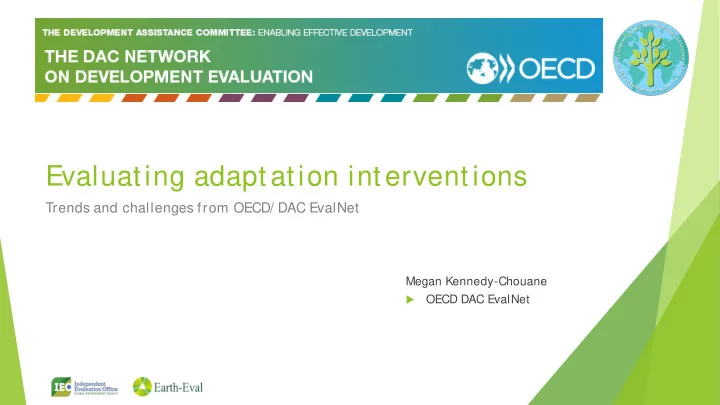

Evaluating adaptation interventions Trends and challenges from OECD/ DAC EvalNet Megan Kennedy-Chouane OECD DAC EvalNet
Who is EvalNet? Network in the OECD Development Assistance Committee (DAC) Bringing together evaluation heads and managers of 30 OECD Ministries of Foreign Affairs as well as development agencies, five regional development banks, the World Bank, IMF and UNDP Providing a forum for dialogue, exchange and knowledge sharing Meetings every 9 months, and task team meetings in between The current Chair of the Network is Per Bastøe (Norway). The Chair is supported by two elected vice-chairs. S upported by S ecretariat (within the Development Co-operation Directorate) of the OECD.
Adaptation: Potential for learning Example of the universal nature of learning and accountability needs in the S DG-era. Many developing countries have lots of experience in evaluating adaptation-focused proj ects and strategies. Development co-operation has more evaluation experience compared to national evaluation in most OECD countries (ex. UK ICF) Drawing lessons from other areas of development evaluation. 10/ 9/ 2019 4
Evaluating climate adaptation Particular challenges : Difference of degree, not type: assessing attribution non-outcomes or “ the dog that didn’ t bark” establishing baselines and targets (shifting baselines) dealing with long time horizons hard and soft adaptation limits (evaluation conclusions) 10/ 9/ 2019 5
Trends among DAC EvalNet members Quick overview of evaluations on DEReC (www.oecd.org/ derec) 22 evaluations of different types 7 evaluations covered climate resilience, adaptation, and other related topics together with other interventions 7 funds/ funding portfolio 4 evaluations of specific adaptation proj ects/ programs 3 syntheses (e.g. one organization over many years) Overall quite limited in terms of number of evaluations and depth of analysis (specifically on adaptation) 10/ 9/ 2019 6
Examples 10/ 9/ 2019 7
Common findings from evaluation reports S everal evaluations found adaptation performing better compared to mitigation, overall: "For adapt at ion, t he overall pict ure is st ronger, wit h around one t hird of t he proj ect s showing very st rong effect iveness and t he maj orit y showing moderat e t o st rong effect iveness." S DC effect iveness report 2014 Synergies underexploited: Climate adaptation and climate mitigation synergies should be harnessed as they are often interlinked to achieve multi-faceted results. Ex. REDD+ Low ownership: Low local partner involvement in intervention design Canada Climat e Change Development Fund evaluat ion, "A maj or short coming of t he CCCDF was t he lack of part icipat ion of developing count ry part ners. Owing t o t he t ime const raint s and t he imperat ive t o meet Government of Canada obj ect ives, t here was lit t le consult at ion wit h developing count ries in set t ing up t he Fund or in proj ect select ion. In some inst ances part nerships were not solidified before proj ect s were approved ." Insufficient action, shallow treatment : Very general interventions, correspondingly evaluation. Inclusion of climate change as crosscutting issue but still regarded as insuf f icient . Frequent recommendations of scaling up of efforts Uneven coverage: S ome sectors, such as clean energy, resilient agriculture receiving more attention than others (as a consequence evaluation pool is also uneven) 10/ 9/ 2019 8
Key messages from synthesis of adaptation mainstreaming Provides an overview of the key concepts in adaptation; lays out the challenges of the M&E of adaptation, and some of the methods and techniques; types of indicators used to measure progress for adaptation interventions; and into the types of evaluations available Mainstreaming adaptation enables systemic and dynamic climate resilient development M&E can help ensure good adaptation mainstreaming Adaptation-specific indicators in mainstreamed adaptation focus on climate and capacity Indicators alone cannot provide insight into adaptation success M&E needs to be fit-for-purpose (it is possible!) Understanding why interventions work is as important as understanding what works: 10/ 9/ 2019 9
Evaluation issues S yntheses identify weak and disparate evidence base (proj ect-level evaluations), barrier to more strategic learning. More focus on the input side of the process, less analysis down the results chain. Also lots of monitoring and over-focus on metrics, less on explanation and causality. Lack of suitable climate change related baseline data, weak monitoring, not allowing detailed evaluation of effectiveness, efficiency and impact Lack of internationally agreed standards for measuring adaptation, and qualitative nature of implicit results (or not defined) and visibility only in the long-term Need for more comprehensive indicators to capture wider effects (geographic / temporal) of climate change related interventions Insufficient coverage of trade-offs though some evaluations (and policies) are becoming more explicit on interrelated nature of climate change topics in defining the scope of evaluations 10/ 9/ 2019 10
Evaluation plan inventory www.oecd.org/ dac/ evaluation/ evaluation-plan-inventory Evaluation gaps? Only 5% of planned or ongoing evaluations focus on climate change and environment (27 of 507 total evaluations planned will look at adaptation) Of these only 5 are specifically on climate change resilience and adaptation 10/ 9/ 2019 11
Thank you! Visit and follow us at: www.oecd.org/dac/evaluation www.oecd.org/derec @ oecd_evalnet @ mkennedychouane Megan.Kennedy-Chouane@ OECD>org 12
Resources Nat ional Climat e Change Adapt at ion – Emerging Pract ice in Monit oring and Evaluat ion Monit oring and Evaluat ion of Climat e Change Adapt at ion: Met hodological Approaches (2014) explores methodological approaches that can be used to monitor and evaluate climate adaptation initiatives at the proj ect and programme level. It focuses on three challenges and the lessons that can be learned from other areas of development practice. Exploring Climat e Finance Effect iveness (2013) explores how different communities view climate finance effectiveness; the policies or institutional pre-conditions that facilitate effectiveness; and how effectiveness is currently monitored and evaluated. 10/ 9/ 2019 13
Recommend
More recommend